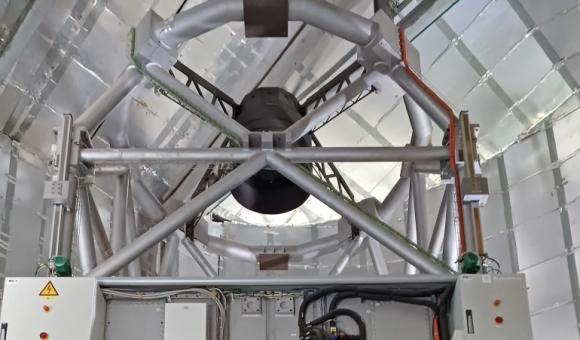Amos Inagurated largest telescope in India18/04/2023
Designed and developed by scientists from the University of Liege and the Indian research institute ARIES, this telescope was built by the Walloon space company AMOS. Its purpose? To observe the cosmos and identify celestial bodies such as supernovae, space debris or asteroids. Located at the Devasthal Observatory in India's central Himalayas, this 4m diameter telescope is the largest and most sophisticated in the world. The images it has produced since its first illumination are already generating enthusiasm among international astronomers.
Liquid mirror telescopes are much cheaper than ordinary telescopes of equivalent size, where aluminised glass is used as the reflecting surface. While the design of this type of instrument is not new, the International Liquid Mirror Telescope (ILMT) is the first liquid mirror telescope entirely dedicated to astronomical observations. Until now, they were mainly used for satellite tracking or military purposes.
The ILMT uses a 4-metre diameter rotating mirror, coated with a thin film of liquid mercury, to collect and focus light. It is a useful complement to the 3.6-metre Devasthal Optical Telescope (DOT), also built by AMOS (Advanced Mechanical and Optical Systems) and already present at the Indian Devasthal Observatory, operated by the Aryabhatta Research Institute of Observational Sciences (ARIES).
Present at the inauguration of the telescope, the rector of the University of Liège, Anne-Sophie Nyssen, was delighted that the University of Liège was at the origin of this project, as the instrument was produced by Amos, a ULiège spin-off. "This once again underlines the skills of our University in the field of space and astrophysics. It is the result of a project that was imagined many years ago and pursued with perseverance by Prof. Jean Surdej, who is responsible for the project. This is an important event for science and international scientific collaboration”.
The Wallonia Export & Investment Agency is equally enthusiastic. "We are happy and proud to see that the number of Indo-Belgian interactions and partnerships in the space sector, as well as in other areas where scientific advances stimulate industry, continues to grow in parallel with the ever-increasing growth of our trade”, says Guillaume de Bassonpierre, Wallonia's Trade and Investment Counsellor in New Delhi.
The installation of these telescopes and their operation is part of the Belgo-Indian Network for Astronomy and Astrophysics (BINA), which currently involves collaborators from six Belgian institutes, including ULiège, and twelve Indian institutes. This growing network was created to increase interaction between Indian and Belgian astronomers and to stimulate the joint use of Indo-Belgian and other telescopes of interest to maximise their scientific output for solar system, galactic and extragalactic celestial objects.
The Belgian Ambassador to India, Mr Vanderhasselt, underlined the importance of joint cooperation through such scientific networks: "Beyond BINA's efforts to stimulate research on the solar system, solar physics, galactic and extragalactic astronomy, BELSPO (Belgian Science Policy) and DST (Indian Department of Science and Technology) are also working together on exciting projects such as cyber security, bioscience, marine science, black holes and climate change.”
Source: https://www.wallonia.be
